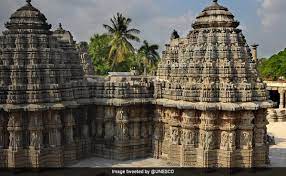
Shantiniketan and Hoysala temples of India got the tag of World Heritage Site
Shantiniketan and Hoysala temples of India got the tag of World Heritage Site
This topic is related to IAS/PCS Prelims Current Affairs “World Heritage Sites of India” and Mains Exam General Studies Question Paper-1 “Indian Art and Culture”.
September 20, 2023
In News:
- Recently, the Hoysala temples of Karnataka and Shantiniketan of West Bengal have been added to the UNESCO list of World Heritage Sites.
- On September 17, 2023, Shantiniketan in West Bengal was officially given the status of UNESCO World Heritage Site. Included in the UNESCO World Heritage List, it is India's 41st World Heritage Site.
- On September 18, 2023, the temples of the Hoysala Empire in Karnataka, India were officially included in the UNESCO World Heritage List, becoming the 42nd World Heritage Site in India to be included in this prestigious heritage list.
- This decision was taken during the 45th session of the UNESCO World Heritage Committee held in Riyadh, Saudi Arabia.
- Many countries including Japan, Nigeria, Oman, Greece, Italy, Russia, Ethiopia, Zambia, South Africa, Qatar, Mali, St. Vincent and the Grenadines, Belgium, Argentina, Mexico, Saudi Arabia and Thailand have supported these historical sites of India as UNESCO.
- Including Hoysala and Santiniketan, India has a total of 42 world heritage sites, which include 34 cultural, 7 natural and 1 mixed property.
- At Present, India ranks sixth in the world with 42 World Heritage Sites.
About Shantiniketan:
- Established in 1901, Santiniketan was initially a residential school based on Indian traditions and the vision of global unity beyond religious and cultural boundaries.
- In 1921, it evolved into a “World University” known as “Visva Bharati”.
- Shantiniketan has a unique architectural style, which is a blend of ancient, medieval and folk traditions of Asia.
- UNESCO World Heritage status recognizes the cultural and educational importance of Santiniketan.
- The unique architecture of the site preserves the heritage and promotes global awareness of Rabindranath Tagore's legacy.
- Shantiniketan was founded as an ashram by Rabindranath Tagore's father, Debendranath Tagore.
- The architectural style of Santiniketan is completely different from the British colonial and European modernist influences of the early 20th century. It draws from ancient, medieval, and folk traditions throughout Asia, including Pan-Asian modernism.
About Hoysala Temples:
- The sacred temples of the Hoysalas are located at Belur, Halebid and Somnathpura.
- According to historians, the Hoysala Empire is considered a patron of art and literature.
- The Hoysala temple, dedicated to Lord Shiva, was built in 1150 AD by the Hoysala king of black polished stone.
- Pictures and statues of gods and goddesses related to Hindu religion have been carved in the temple.
- The Chennakeshava Temple at Somnathpura in Karnataka was built in 1268 AD under the supervision of Narasimha III.
- Keshava Temple at Belur in Hassan district of Karnataka is built by Vishnuvardhana.
- Gods, Goddesses and musicians are carved on the walls of Keshav Temple.
- The style of these temples is neither completely Dravidian nor completely Nagara.
- These temples are built in a unique style.
- At Present, these temples are conserved by the Archaeological Survey of India i.e. ASI.
About UNESCO:
- The United Nations Educational, Scientific and Cultural Organization (UNESCO) is a specialized agency of the United Nations (UN).
- It is a member of the United Nations Sustainable Development Group (UN SDGs), a coalition of United Nations agencies and organizations.
- Its main objective is to meet the Sustainable Development Goals (SDGs).
- Its headquarters is in Paris, France.
- Currently, its Director General is Audrey Azoulay.
- This organization was established on 16 November 1945 in London, United Kingdom.
- At present, this organization has 193 members and 11 associate members.
--------------------------------------------
Mains Exam Question
1. The timeless beauty of the Hoysala temples is a testament to the rich cultural heritage of India and the extraordinary craftsmanship of our ancestors. Discuss.
2. Shantiniketan's unique architectural style, which is a blend of ancient, medieval and folk traditions of Asia. Discuss.